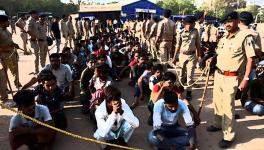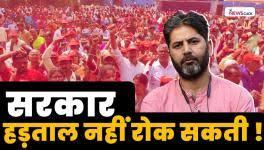CAA-NRC Protests Are Silver Linings on India’s Horizon

Indians are in revolt. Enough is enough. Selling dreams of a ‘New India’ and simultaneously selling communal hatred cannot go on indefinitely. The people were probably waiting for a catalyst, which the Narendra Modi government unwittingly put on their platter in the form of the Citizenship Amendment Act, 2019.
For the first time in India’s history, an Act made citizenship contingent upon one’s religion, targeting Muslims in particular. The government might have guessed that it would further strengthen its Hindu base. But the strategy seems to have boomeranged. It has electrified India’s largely dormant secular constituency and put large parts of the country on fire. The agitators’ demand cannot be simpler: ‘please honour the Constitution’.
India has walked down a similar path twice in its past. In 1974-75, student unrest against a fee hike in Gujarat culminated in a mass movement across north India that demanded Sampoorna Kranti (total revolution). The slogan was coined by Jayaprakash Narayan, a Gandhian of the nationalist vintage and the driving force behind the movement.
In 2011, yet another mass movement emerged around the nucleus of Anna Hazare’s hunger strike against rampant corruption during Manmohan Singh’s second term in office (2009-14). Both agitations resulted in changes of government. The first ended Indira Gandhi’s rule (1971-77, that included her Emergency regime, 1975-77), while the second unleashed the Modi phenomenon.
Notably, both upsurges benefited the Rashtriya Swayamsevak Sangh/Bharatiya Janata Party. Thanks to their organisational base they were quick to appropriate them. The opposite is happening now. Leave alone being a part of the present upsurge, they are instead on its receiving end.
At stake is India’s secularism, which the BJP has been systematically attacking in the name of its Hindutva project. Large sections of students who were already up in arms against the Modi government have now been joined by a cross-section of Indians, most prominently Muslims, all of whom are outraged by the discriminatory aspects of the new Citizenship Act and what has been generally happening to them of late. Howsoever the Modi government may try to obfuscate the issue, by making contradictory statements, the cat is out of the bag and the trick lies exposed.
Can ‘Modi magic’ still manage to douse the fire? Or have the battle lines between the forces of secularism and those of a Hindu Rashtra been irrevocably drawn? The situation is ominous because the spectre of a virtual civil war is no longer a purely abstract possibility. The RSS has tasted blood during the Modi regime and it is unlikely to squander its gains easily. Prime Minister Atal Bihari Vajpayee’s time was marked by a constant, simmering tension between the government and the RSS. In the Modi era it is a honeymoon all the way.
Thanks to the expansion of its shakhas (branches) at the grassroots level across the country, the RSS has never been as strong as it is today. As Walter K Andersen and Shridhar D Damle point out, in RSS: A View to the Inside (2019), since the early 1990s, the RSS has expanded its membership to about two million and become one of the world’s largest NGOs. It organises nearly 57,000 daily shakhas, 14,000 weekly shakhas, and 7,000 monthly shakhas. In 2016, these shakha meetings were held in 36,293 places spread all over the nation. To supplement this popular connection, there is a virtual reserve army of about six million alumni and affiliate volunteers. And the pace of growth continues to accelerate: from 51,332 daily shakhas in 2015, the number jumped to 57,000 in 2016.
Now add to this huge organisational base, Modi’s unprecedented personal popularity. Pandit Nehru and Indira Gandhi were also very popular, but Modi has far outpaced them. It is mind-boggling to watch the mass hysteria reflected in such incessant chants as ‘Mo-o-o-o-di, Mo-o-o-o-di, Mo-o-o-o-di’ in all his rallies. No wonder, then, whether it is a state election in Jharkhand or a quasi-state election in Delhi, the only commodity BJP finds sellable, given its dismal governance record, is the Modi persona. That the overuse of the Modi trump card will eventually tell upon the health of the BJP in the long run (much as Congress’ reliance on Indira did), is a subject for another time.
But it does beg one question: How long will the momentum of the present upsurge against Modi and the RSS/BJP be maintained? A leaderless movement does not generally last long. The fate of the Arab Spring is a stark reminder. But perhaps this comparison does not hold water. Unlike the Arab world, India has extended experience in democratic experimentation (starting with Mahatma Gandhi joining the nationalist movement in 1915). India is also plural in multiple senses. As such, howsoever leaderless India’s mass upsurges may appear, there is an in-built order to the spontaneous crowds that have now become routine.
Whether the upsurges will ultimately challenge the RSS/BJP juggernaut remains to be seen. In the meantime, three key developments, each positive, each a credit to the protesters, are impossible to ignore. One, the upsurges are spontaneous, with no party sponsorship. Two, they have brought the country’s totally marginalised Muslims back into the political mainstream. And finally, students and the youth at large, whose grievances are essentially mundane, that is, lack of jobs and opportunities, have found broad-based support for their cause, evincing memories of the JP movement of 1974-75.
The most exciting element of these upsurges, however, is their demand for the restoration of the glory of India’s secular and inclusive Constitution. The sheer simplicity of this demand has even forced the RSS/BJP Siamese Twins to play on the back foot. In a sight never witnessed before in India, men, women, and children have taken to reading aloud the Preamble to the Constitution of India:
‘WE, THE PEOPLE OF INDIA, having solemnly resolved to constitute India into a SOVEREIGN SOCIALIST SECULAR DEMOCRATIC REPUBLIC and to secure to all its citizens JUSTICE, social, economic and political; LIBERTY of thought, expression, belief, faith and worship; EQUALITY of status and opportunity; and to promote among them all FRATERNITY assuring the dignity of the individual and the unity and integrity of the Nation; IN OUR CONSTITUENT ASSEMBLY this 26th day of November 1949, do HEREBY ADOPT, ENACT AND GIVE TO OURSELVES THIS CONSTITUTION.’
On what grounds can the Modi government judge these protesters anti-national? That well-tested cynical trick was first deployed at a Jawaharlal Nehru University (JNU) student event in February 2016. By making dubious allegations that Kanhaiya Kumar, then the president of the JNU Students Union (JNUSU), had said, ‘let the country be dismembered into pieces’, a new sarkari (i.e. government-sponsored) abuse was coined.
Suddenly, the country was overrun with the ‘tukde-tukde gang,’ and anybody who disagreed could be charged under the draconian British-era Sedition Act. Kanhaiya Kumar’s protestations that the videos of the event, screened by a pliant media unable to maintain basic journalistic standards, were doctored to malign him, fell on deaf ears; so much so that the Delhi Police put him in jail. In an ironic turn, and no doubt much to the BJP’s chagrin, imprisonment turned out to be a boon for Kanhaiya. He may have entered jail as a student leader, he stepped out an iconic, national figure, a spokesman for India’s democratic values. His jail diary in Hindi, From Bihar to Tihar (name of the jail where he was imprisoned), is a runaway bestseller.
The BJP made Kanhaiya Kumar a hero. They are now repeating the mistake and making the current JNUSU President, Aishe Ghosh, a future heroine of Indian politics. It is surprising how much the party hates JNU, which is not only a leading university but also one whose student community is congenitally vocal against the political establishment, be it the BJP, the Congress, or anyone else.
Recall that during Indira Gandhi’s Emergency, JNU students were particularly targeted and many languished in jail for months. But unlike during the Emergency, the BJP’s animus against JNU appears to be driven by an intense disrespect for scientific temper and intellectual debate. As such, JNU is routinely criticised for its Leftist politics. But this criticism ignores the fact that its students are politically progressive, inspired by an idealism that is essential to youth. After all, if one doesn’t question norms and dream of a better world when one is young, it is far less likely one will do so when older. It is sad, therefore, to see them abused as the ‘tukde-tukde gang’, ‘urban Naxals’, and, most offensively, as ‘anti-nationals’.
Let us face it: Indian youth and minorities today are restless. The Magsaysay Award winning TV anchor Ravish Kumar recently ran a long series on the state of higher education in India’s Hindi heartland, which is, paradoxically, also India’s political heartland. Whether the states are ruled by the BJP or the Congress, they suffer from total neglect in terms of teacher-student ratio, chronic absenteeism of teachers, virtually non-existing classrooms, libraries, toilets, and much else. Under these circumstances, it is evident that the political class has successfully brainwashed the middle classes, who otherwise would beg, borrow or steal to buy the best education for their wards. Instead of demanding better education, they toe the BJP line and complain about students misusing their “tax-payers’ money”. Where is their concern when the BJP spends Rs 3,000 crore (£330million, $430million) of their “tax-payers’ money” to build a statue of Sardar Patel, that too by sourcing most of the materials from China?
One last point. Of all liberal arts disciplines, history has earned the dubious distinction of being, on the one hand, dismissed as worthless and wholly dispensable, and yet on the other hand, the beneficiary of intense government meddling. In a recent speech in Kolkata, Prime Minister Narendra Modi authoritatively claimed that historians have only studied political power struggles; they have completely neglected the common man and his problems. I wish Modi’s speech-writer had done some elementary reading about the subaltern school of history.
Professor Ranajit Guha pioneered the school about 50 years ago. Historians belonging to the school have produced volume after volume detailing precisely what Modi, falsely and ignorantly, laments does not exist. And they have influenced the way historians work the world over. But why am I not surprised? Modi has also tried to teach economics to Amartya Sen.
Postscript: At a conference held in Dehradun a year ago, I had a friendly chat with Murli Manohar Joshi, a long-time BJP MP and Vajpayee’s Human Resource Development minister from 1999 to 2004. Joshi had delivered a talk in the morning focusing on the science-social science interface. The talk was brilliant, and after expressing my appreciation, I could not resist adding, tongue firmly in cheek: ‘Sir, you should belong not just to the BJP, but to the entire country.’ He immediately got my point: Why was it that politicians turn much saner and circumspect the moment they are out of circulation? Was Joshi not the same HRD Minister who had actively promoted the RSS agenda to rewrite history from a Hindutva perspective? Sadly, that same project is now poaching into natural sciences as well, if one goes by the statements of India’s present HRD Minister, Ramesh Pokhriyal. One shudders to think about the day when India’s Mars Mission rocket will lift off based not on astronomical calculations but on astrological conjunctions—waiting for the propitious muhurta (moment)!
The author is senior fellow, Institute of Social Sciences, New Delhi, a former ICSSR national fellow and taught South Asian Studies at JNU. The views are personal.
Get the latest reports & analysis with people's perspective on Protests, movements & deep analytical videos, discussions of the current affairs in your Telegram app. Subscribe to NewsClick's Telegram channel & get Real-Time updates on stories, as they get published on our website.























